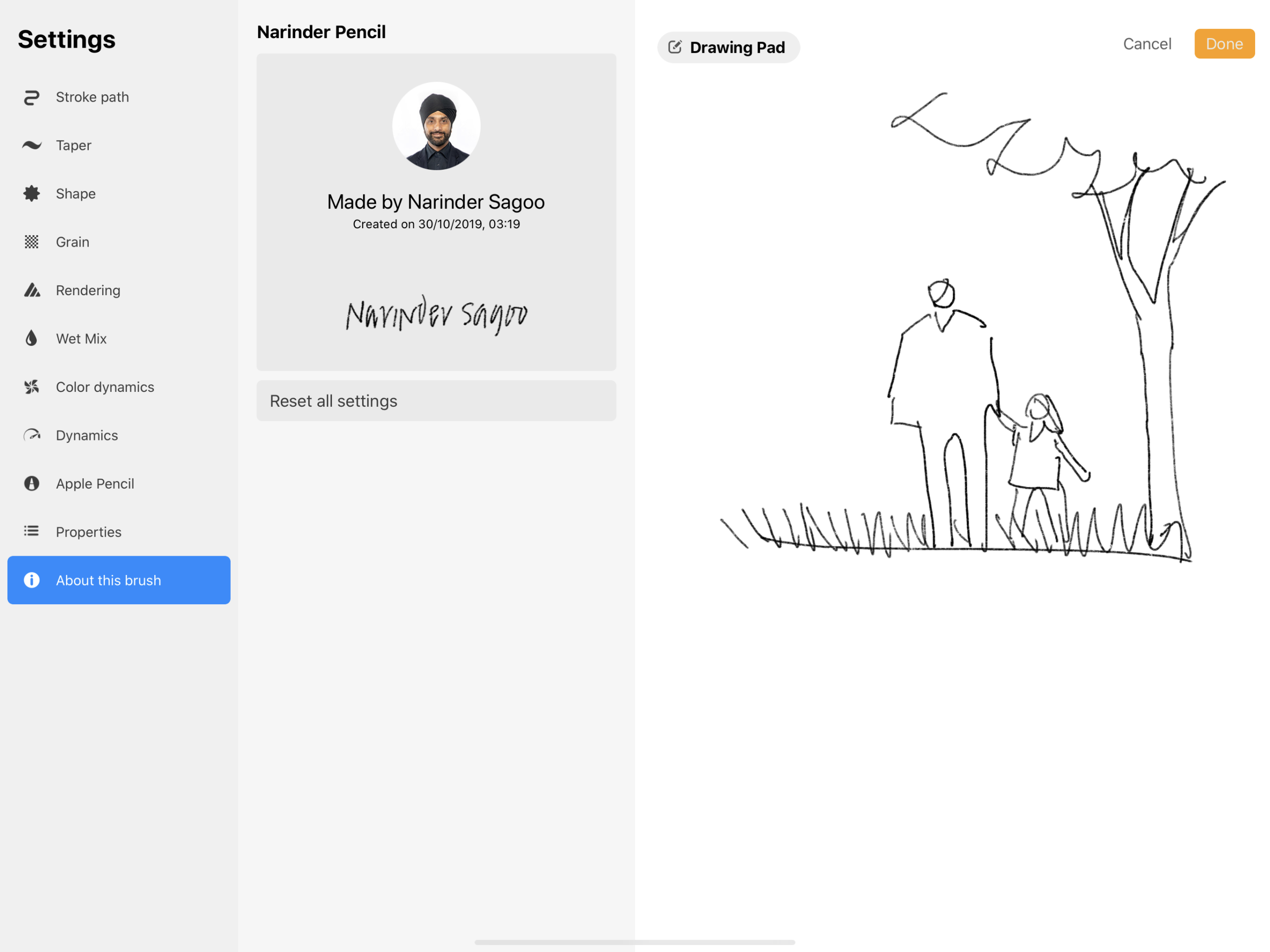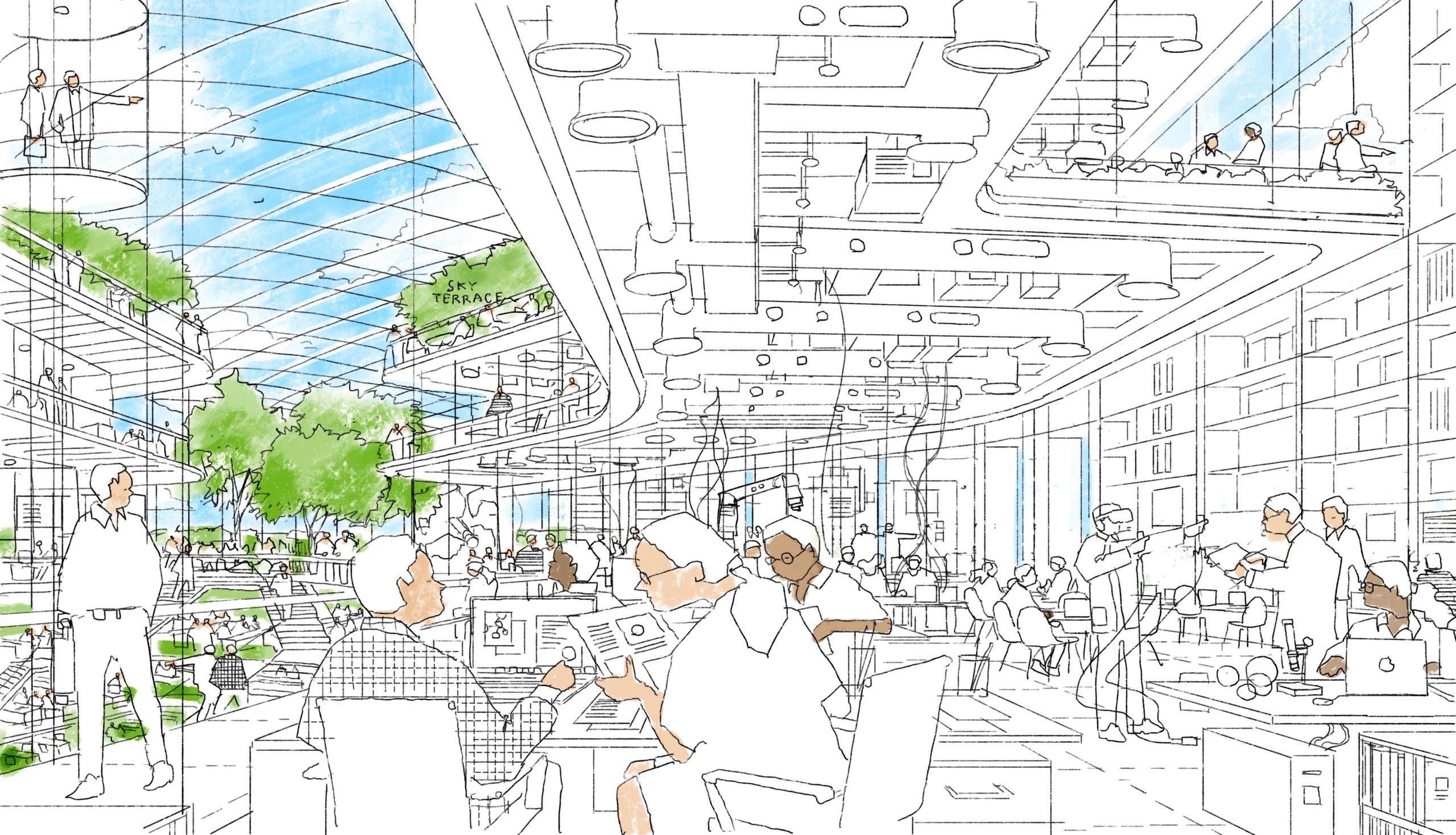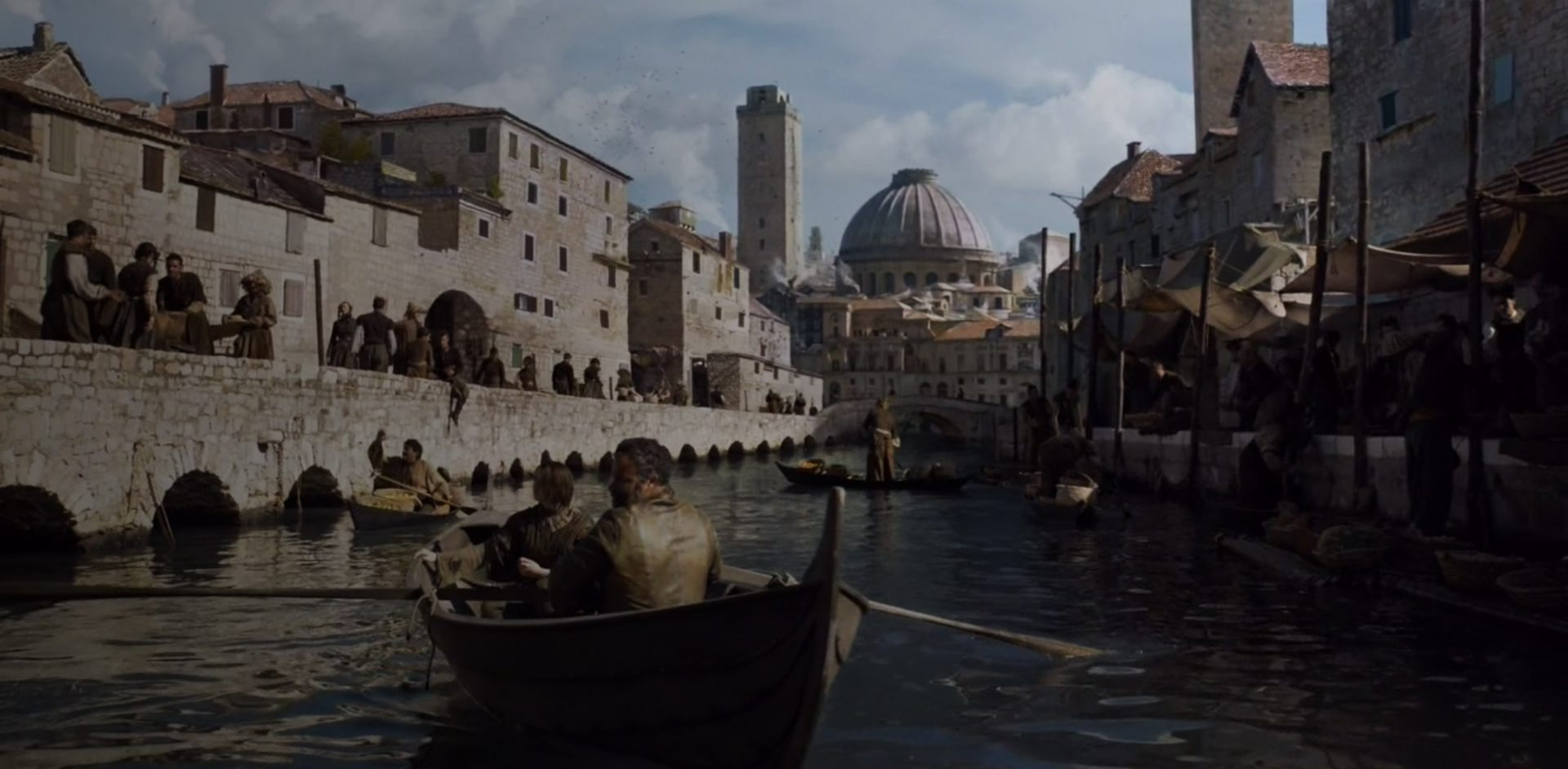Renowned UK practice Foster + Partners is known for its integrated approach to design, with iconic buildings all over the world. However, despite the firm’s technological focus, its designers continue to draw, paint and sketch their ideas, while also modeling and rendering them on computers.
Today, these analog and digital techniques are merging in innovative new ways, and Foster + Partners is taking full advantage. Senior Partner and Art Director Narinder Sagoo believes in the synthesis of traditional and modern drawing tools, leading a team of artists that are harnessing technology to create pioneering presentations and help the design teams win projects.

Narinder Sagoo with design team members at Foster + Partners’ working on Procreate; image via Foster + Partners
Architizer sat down with Sagoo to discuss his use of Procreate, highlighting its game-changing potential and speculating about the future of designing via touchscreen.
Paul Keskeys: What kinds of tools do you rely on most when developing architectural concepts?
Narinder Sagoo: We’re a team of artists, so we do use very traditional tools — sketch books, paper, canvases, large sheets of tracing paper, watercolors — the tools that we’ve been brought up with. But we’re also surrounded by amazing digital hardware and software. Those analog tools have always been mobile; you can carry everything in your bag wherever you go, whether it be sketchbooks, pencils, charcoals, pens, ink. Until recently, the digital tools have tended to be very much tied down to the office environment, plugged into the ground and connected to servers and render farms.
For me personally, I’ve always drawn in an analog way growing up, and when I started at Foster + Partners 23 years ago. So, when it became possible to put a hand sketch from a piece of tracing paper onto the computer, that was very exciting to me. It sounds so simple now, but at the time it was quite revolutionary! Being able to scan a drawing and have it in pixels in Photoshop, and to then be able to paint over the top, really changed the game. I would draw at A3, blow them up to A1 and color them by hand, and then they would form part of the presentation to clients. But still, the resolution would be dependent on the original piece of paper that it was drawn on.
You can imagine how powerful being able to carry a digital workspace in my pocket was in my workflow and in our lives as artists. This could be the iPhone, the iPad Mini I have in my blazer, or the iPad Pro that I have with me all the time. In truth, I still surround myself with pencils and oils and ink and whatever I need around me, but the iPad has become a very powerful tool within our studio.

Concept drawing for Harvard proposal, created on Procreate; image via Foster + Partners
From a software point of view, Procreate enables me to draw on canvases that are thousands of pixels wide. I complete drawings on my commute to work or when I’m flying from one country to another. I use it sat in my armchair at home and then continue that drawing at work, and wherever I might be. It’s given me an endless amount of choice and agility in my workflow. I’m able to create my own pencils, and use pencil or ink, or paint as if I’m using acrylics on Procreate. I can carry my whole studio in my pocket within one device, which is just unbelievably transformational in my life as an artist.
That’s amazing! Are there any specific tools on Procreate that you would say are your “go to” tools, or any particular ones that you think are especially useful to architects?
Yes. As any architect knows, you have one or two types of pen or pencil that fit into the style of your practice and look good on the drawing board, so for consistency you and your colleagues must use the same kind of pen. One of the first things I did on Procreate was try to recreate a 0.9 technical pencil. I did that by scanning the texture that the pencil created — the actual pencil — and creating a point using the brush maker in Procreate.
I have also disposed of my ruler. I always used to draw with a mixture of straight lines and freehand lines, so I could speed up or add accuracy wherever I wanted to. With Procreate, that’s been replaced by drawing guides, perspective guides and grids that I can just enable with the flick of a finger. I’ve got a quick menu that I use to enable those guides.

The “Narinder Pencil” on Procreate; image via Foster + Partners
Then, I have my own pencil that I’ve created — the “Narinder Pencil” that Procreate very kindly added to their platform. I’m a real fan of being able to share what we know, so I thought if we could share that tool amongst everyone who has Procreate among the world, that would be amazing. The act of not just creating a tool or a brush, but to be able to share it too, I think, is an incredible thing — not just for me or my team, but for everyone creating any kind of artwork.
This is where I think Procreate, with its ability to change your workspace, is perhaps a new revolution in the art world. You can categorize it as digital, but it’s still so analog in terms of it being completely open source and hackable. The artist’s studio is no longer a sacred place where tools are bespoke to one person, and you’re just left wondering how those marks are made. Now we have an environment in which we can share those tools.
Was there a particular project where you felt like Procreate made all the difference, or a project where you realized the app’s full potential?
I think a key moment was when I realized that Procreate recorded every brushstroke or pencil mark I was making, and recorded it as a 4K resolution time-lapse. I enjoy drawing in solitude — it’s a great kind of therapy and meditation — but often the best drawings we produce are ones when we are telling stories to each other, talking and drawing at the same time. I’ve always been fascinated by watching other people draw whilst they talk.
So, to find that any drawing that I produce in solitude is being recorded, and I can then play it back to people, was quite a wonderful moment. I tend to almost talk in my mind whilst drawing, so I’m telling a story with a sequence that I use. I often start drawing people, landscape and life before the architecture. The architecture always comes later; it comes as a consequence of the place that we’re trying to create. I take that for granted, but it’s only until people started watching my time-lapse movies from Procreate that they pointed that out to me.
Once I realized I could export those movies, I was able to be slightly more careful about the sequence I was drawing in and started to create animations that we could then present to clients. With slight edits — a change in the animation’s speed, the addition of music, and so on — something that’s taken me a couple of hours can then be presented to a client. There was one movie I did using Procreate on a two-hour flight — the animated version of that drawing was instrumental in winning us the project.
The feedback was that the animation left the client feeling involved within the process itself. It was just a sketch, it was a painting; it was evocative, it had music, the movement was captivating, but most importantly, it wasn’t the final solution. The client therefore felt they were choosing not a scheme but a team on that day. We represented a way of working that was always going to involve the client.

“Lab of the Future” concept drawing created on Procreate; image via Foster + Partners
There’s been many examples like this. We presented another urban scale proposal through an animated sequence of drawing all drawn in Procreate. That was the only thing we presented, and we won. I find it’s such a wonderful enabler. There’s always new possibilities in Procreate — every time there’s a new update, I find new ways of tailoring it to my workflow.
In Procreate 5, there are tools that allow you to create more controlled animations. For example, I’m going to sit with our head of environmental engineering in the next week or so and get him to use Procreate to animate environmental drawings for buildings, so he can illustrate solar paths and wind arrows, add annotations and so on, to bring his engineering drawings to life.
How you think touchscreen apps might evolve in the future to better serve architects and designers?
I think we could create an even more collaborative environment. I would love to be able to draw simultaneously with someone across the globe, on the same piece of digital paper.
We could bring a sense of magic from our childhood that is inherent in the creative process into the professional environment. My daughter and I use Procreate on the weekends — she chooses any brush she wants, and she scribbles. She then gives me the pencil, and we find faces and shapes within her scribbles. We add legs to a scribble, maybe add a beak and turn it into a bird, or we revolve it and turn it into an elephant, or a building, or whatever it might be. She enjoys that because she’s discovering creativity directly through mark making. I enjoy it because it liberates that childhood innocence in my mind, and being able to discover things within marks that I’ve made.
I think in a professional sense I’d like to do that more with colleagues, where we draw together. I might draw something on a piece of paper. Someone might see it very differently, turn it around and draw something else on it. We’d have that same level of creativity and exploration that I have with my daughter, but within a professional environment, from several locations across the globe
To try Procreate 5 for yourself, head this way.
Note: Narinder Sagoo is Art Director at Foster + Partners, leading a team of 18 artists who support the design teams. Narinder and his team use Procreate for iPad and iPhone as one of several digital tools . The above represents Narinder’s personal experience of using Procreate and is not a formal endorsement by the practice and neither Narinder nor the practice have been paid for this interview.









